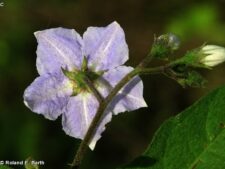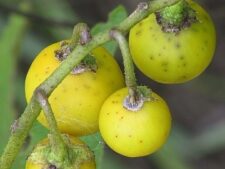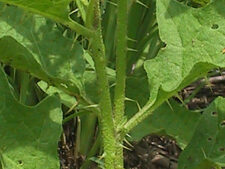
HORSE NETTLE
Solanum carolinense
NIGHTSHADE FAMILY (Solanaceae)
 Identification
Identification
- Flowering time - May, June, July, August, September
- Disturbed soils in open woodlands, prairies, roadsides
- Prickly stem and leaves
- Showy, star-shaped flowers with 5 petals
- Prominent yellow banana-shaped anthers
This perennial believed to be native to the southeastern U.S. is now well established in our area. The stems, up to 2 feet tall, have long yellowish prickles (F). The leaves, up to 4 inches long, have wavy margins and are often deeply lobed. Prickles also occur along the main veins on the underside of the leaf. The distinctive star-shaped, white to light violet flowers are found in showy clusters at the end of the upper stems (B,D). They have 5 petals which are fused at the base turning blue or lavender with age (C), and 5 bright yellow anthers which resemble tiny bananas (A,C). The fruit is green berry about 1/2 inch in diameter that turns yellow as it matures (D).
These plants bloom from May through September, but primarily in June and July. They occur in areas where the soil has been disturbed and are uncommon in woodland openings, along roadsides and in our prairie restorations.
Horse Nettle, especially the fruit, is poisonous to livestock and humans. It is considered a weed in Nebraska.
The prickly stem and leaves have prompted many, often colorful, common names for this plant including Sand Briar, Bull Nettle, Apple of Sodom, Thorn Apple, Wild and Devil’s Tomato.
The content of NatureSearch is provided by dedicated volunteer Naturalists of Fontenelle Forest who strive to provide the most accurate information available. Contributors of the images retain their copyrights. The point of contact for this page is: Roland Barth.





